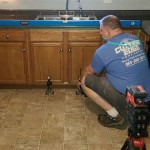What Is the Standard Size Kitchen Trash Can in China?
Understanding the dimensions of kitchen trash cans in China requires navigating a landscape influenced by factors such as kitchen size, household habits, and evolving design trends. While a universally mandated "standard" size does not exist in the same way it might for appliances adhering to specific industry regulations, preferred dimensions and capacities emerge from common usage and market availability. This article explores the typical sizes of kitchen trash cans found in Chinese households, the elements shaping these preferences, and comparisons to trash can sizes in other regions.
The absence of a fixed standard size stems from the diverse living conditions across China. Urban apartments often feature compact kitchens, while rural homes may have more expansive spaces. Consequently, the ideal trash can size varies significantly. What constitutes a suitable size in a bustling city like Shanghai might be drastically different from what is appropriate in a smaller, provincial town.
Furthermore, differing waste disposal practices influence trash can selection. Higher population density areas may have more frequent waste collection services, leading to a preference for smaller, easily manageable trash cans. Conversely, regions with less frequent service might necessitate larger capacity bins. Therefore, understanding the specific needs and waste management infrastructure of a particular area is crucial when determining the appropriate trash can size.
Typical Capacity Ranges
While no single definition exists for a "standard" size, certain capacity ranges are more prevalent than others in Chinese kitchens. These ranges are generally dictated by practical considerations and the volume of waste typically generated by a household. The following capacity ranges are frequently encountered:
Small Capacity (5-15 Liters): These smaller bins are commonly found in bathrooms or used as countertop containers for food scraps. In kitchens, they are often employed as secondary trash receptacles for specific types of waste, such as recyclables or compostable materials. Their compact size makes them suitable for space-constrained kitchens and for households with minimal waste production.
Medium Capacity (15-30 Liters): This range represents a very popular choice for many urban households. Trash cans in this capacity are large enough to accommodate daily kitchen waste without requiring excessively frequent emptying. They strike a balance between capacity and space efficiency, making them well-suited for apartments and smaller homes. Pedal-operated or sensor-activated models are often available in this size, adding a layer of convenience and hygiene.
Large Capacity (30-50 Liters): Larger households, or those with more significant waste generation, often opt for bins in this category. This size is particularly useful for families or individuals who cook frequently and produce a substantial amount of food waste. These bins are also suitable for homes with less frequent waste collection schedules, as they can hold more waste between collections. While generally used in homes with greater kitchen areas, these sizes are not uncommon in smaller kitchens where waste volume is the key consideration.
Extra-Large Capacity (50+ Liters): Trash cans exceeding 50 liters are typically reserved for commercial kitchens, restaurants, or larger households with exceptionally high waste production. Their size makes them less practical for the average domestic kitchen in China, where space is often at a premium. These larger containers are usually constructed from durable materials, such as stainless steel or heavy-duty plastic, to withstand the weight and volume of waste they are designed to hold.
Factors Influencing Size Selection
Several key factors drive the decision-making process when selecting a kitchen trash can size in China. These factors extend beyond mere kitchen dimensions and encompass lifestyle choices, environmental considerations, and cultural preferences.
Kitchen Size and Layout: The physical dimensions of the kitchen are arguably the most influential factor. Smaller kitchens necessitate compact trash cans to maximize available space. In contrast, larger kitchens can accommodate larger bins without compromising functionality. The layout of the kitchen, including the placement of cabinets, countertops, and appliances, also plays a role in determining the most suitable location and size for the trash can.
Household Size and Habits: The number of people residing in a household directly correlates with the volume of waste generated. Larger families naturally produce more waste, requiring larger trash cans. Cooking habits also contribute to waste generation; households that frequently prepare meals from scratch tend to produce more food waste than those that rely heavily on takeout or pre-packaged foods. The frequency of dining at home versus externally further impacts waste volume and consequently, trash can size.
Waste Disposal Practices: Local waste disposal regulations and infrastructure significantly impact trash can selection. Areas with mandatory recycling programs may require separate bins for recyclable materials, reducing the volume of general waste and potentially allowing for smaller trash cans. The frequency of waste collection services also plays a pivotal role; areas with frequent collection can utilize smaller bins, while areas with less frequent collection necessitate larger capacity options.
Environmental Awareness: Growing environmental awareness is increasingly influencing consumer choices regarding waste management. Many households are now segregating waste for recycling and composting, leading to a need for multiple trash cans of different sizes. Smaller bins may be used for specific waste streams, while a larger bin is reserved for general waste. This shift towards more sustainable waste management practices is impacting the demand for different trash can sizes and types.
Aesthetics and Design: The aesthetic appeal of kitchen trash cans is also a consideration for many consumers. While functionality remains paramount, many individuals seek trash cans that complement their kitchen décor. Various styles, colors, and materials are available, allowing consumers to choose options that blend seamlessly with their existing design scheme. Modern kitchens often feature sleek, minimalist trash cans that are both functional and visually appealing. Sensor and step-operated models are also popular as they limit contact with germs.
Regional Variations
China's vast geographical expanse and diverse cultural landscape contribute to regional variations in kitchen trash can preferences. These variations are shaped by factors such as economic development, urbanization rates, and local waste management practices.
Urban Centers: Major urban centers like Beijing, Shanghai, and Guangzhou tend to favor smaller, more space-efficient trash cans due to the prevalence of smaller apartments. The higher population density in these cities often leads to more frequent waste collection services, reducing the need for larger capacity bins. Moreover, the sophisticated recycling infrastructure in some urban areas encourages waste segregation and reduces the volume of general waste.
Coastal Regions: Coastal regions, with their relatively higher levels of economic development, often exhibit a greater emphasis on aesthetics and hygiene. Stainless steel trash cans with sensor-operated lids are popular choices in these areas, reflecting a preference for modern, hygienic solutions. The relatively affluent population in these regions is also more willing to invest in higher-quality trash cans with advanced features.
Rural Areas: Rural areas may exhibit a greater preference for larger capacity trash cans due to less frequent waste collection services. Households in these areas often rely on larger bins to store waste between collections. Due to lower urban density, homes in rural areas may have more space for larger trashcans. Traditional, simpler designs are also common in these regions, reflecting a focus on functionality and affordability.
Tier 2 and Tier 3 Cities: These cities are experiencing rapid economic growth and urbanization, leading to evolving preferences for kitchen trash cans. As housing densities increase, space-saving solutions are becoming more popular. At the same time, rising incomes are driving demand for higher-quality, more aesthetically pleasing trash cans. The adoption of sustainable waste management practices is also gaining momentum in these cities, influencing the demand for different trash can sizes and types.
In conclusion, while a single "standard" size for kitchen trash cans in China remains elusive, specific capacity ranges and influencing factors stand out. Understanding these nuances allows for a more informed assessment of the market and the needs of individual households. The convergence of kitchen size, household habits, waste disposal practices, and increasing environmental awareness collectively shape the landscape of kitchen trash can preferences across China.

60 Litter Recycling Garbage Bins Whole Kitchen Dustbin Plastic Trash Cans China And Bin Made In Com

Kitchen Plastic Large Capacity Wall Mounted Cabinet Door Hanging Type Trash Can Bin With Lid China Container And Food Made In Com

Huasheng Big Stainless Steel Dustbin Trash Can Garbage Waste Bin Bucket Kitchen Hotel China And Stretcher Made In Com

Kitchen Plastic Large Capacity Wall Mounted Cabinet Door Hanging Type Trash Can Bin With Lid China Container And Food Made In Com

Happimess Connor 13 Gal Rose Gold Rectangular Trash Can With Soft Close Lid And Free Mini Hpm1006d The Home Depot

Smart Trash Can Automatic Refuse Bin Touchless Waste Basket Kitchen For Home Car Hotel And Outdoor Use China Dustbin Plastic Made In Com

Bestoffice Touch Free Sensor Stainless Steel Trash Can 13 Gallon Com

Beamnova Black Stainless Steel Trash Can Kitchen

Extra Large Wood Trash Bin Unfinished Can Cabinet With Trim Amish Handmade Made In Usa 50 Qt

Innovaze 3 2 Gal 12 Liter Fingerprint Free Brushed Stainless Steel Semi Round Step On Trash Can Mgcs As1807 The Home Depot
Related Posts








